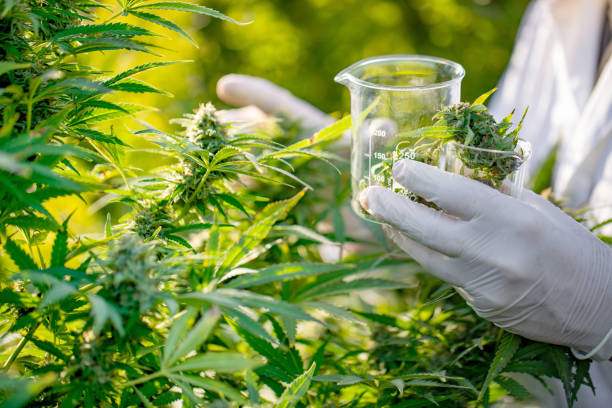Cannabis is a plant that has fascinated cultures around the world for centuries, not just for its psychoactive properties but also for the complexity and richness of its composition. Among the various compounds present in cannabis, terpenes have sparked particular interest for their significant role in shaping the user experience. Understanding it and its effects can enhance your appreciation and interaction with cannabis, whether you’re smoking joints out front swapping good times or utilizing it for medicinal purposes.
In this article, we’ll explore:
- Its defining characteristics and their presence in the cannabis plant, highlighting their contribution beyond mere aroma to include significant effects on mood and sensation.
- Its intricate relationship with cannabinoids, detailing how these compounds interact to enhance or modify the therapeutic and psychoactive effects of cannabis through the entourage effect.
- Practical insights on how consumers can leverage knowledge to tailor their cannabis consumption experience, whether seeking specific therapeutic benefits or particular sensory experiences.
What Are Terpenes?
They are aromatic compounds found in many plants, though they are perhaps most commonly associated with cannabis because of their high concentration within it. These compounds are what give cannabis strains their distinctive aromas and flavors, ranging from citrusy and sweet to earthy and musky. However, they do more than just affect how cannabis smells and tastes; they also influence its effects on the body and mind.
The Role in Cannabis
Enhancing the Entourage Effect
- Entourage Effect Explained: They play a critical role in what is known as the “entourage effect.” This theory suggests that cannabis’s various components, including cannabinoids (like THC and CBD) and terpenes, work together synergistically to produce more pronounced benefits than any single compound could on its own.
Modifying Effects
- Modulation of Effects: Depending on their specific profile, they can modify the intensity and quality of the high experienced by users, influencing factors such as clarity, mood, and energy levels. This means that the presence of a certain amount can make one strain uplifting and energizing while making another more calming and sedative. By paying attention to the content of a strain, you can tailor your cannabis experience to your desired outcome.
Potential Medicinal Uses
- Medicinal Benefits: They have been found to have potential medicinal benefits, such as anti-inflammatory and antioxidant properties. Some studies also suggest that certain part may play a role in reducing anxiety and depression and improving focus and memory. As our understanding expands, there may be more potential for using them medicinally.
Common Types and Their Effects
Terpenes and effect profiles can vary significantly between strains and even within the same strain. However, here are a few of the most common varieties found in cannabis and their potential effects:
- Myrcene: Often found in mangos, myrcene is known for its relaxing and sedative properties. It’s common in indica strains, contributing to the classic “couch-lock” effect.
- Limonene: With its distinct citrus scent, this is believed to elevate mood and relieve stress. It’s prevalent in many sativa strains that are known for their uplifting effects.
- Pinene: True to its name, pinene smells like pine trees and can enhance alertness and memory retention. It may also counteract some THC effects, such as short-term memory loss.
- Linalool: With a floral and lavender aroma, linalool is valued for its calming and anti-anxiety properties. It’s found in strains used for stress relief and relaxation.
- Caryophyllene: This spicy, peppery variety can bind to CB2 cannabinoid receptors in the body, contributing to its anti-inflammatory and pain-relieving effects.
How to Choose the Right One for You
Knowing the potential effects of different types can help you make informed decisions about which cannabis strains will best meet your needs or desired experience. Here are some tips to guide your selection:
- Identify Your Desired Effects: Start by considering what you want from your cannabis experience—whether it’s relaxation, pain relief, energy, or creativity.
- Research Strains: Look into the profiles of various strains to find ones that match your desired effects. Many dispensaries and cannabis brands provide this information.
- Ask for Recommendations: Don’t hesitate to ask budtenders at dispensaries for their insights on profiles and how they might align with your preferences.
- Experiment Carefully: Everyone’s body chemistry is different, so those that has one effect on one person may have a different effect on another. Start with small doses to see how you react.
Exploring in Different Consumption Methods
While smoking and vaping are popular methods of cannabis consumption, their presence also impacts the experience through other modes, such as edibles and topical applications. Here’s how they play a role in various consumption methods:
- Edibles: The process of cooking or baking cannabis can alter its profiles, but innovative formulations aim to preserve these compounds to maintain their effects when ingested.
- Topicals: These topical cannabis products can offer targeted relief from inflammation and pain. The skin’s absorption of these aromatic compounds can also provide aromatherapy benefits.
- Other Forms: These can also be found in tinctures, concentrates, and oils. The method of extraction and type of cannabis used will impact the specific profile.
The Future of Research in Cannabis
The ongoing research holds significant potential for both the medical and recreational cannabis communities. Scientists continue to explore how these aromatic compounds contribute to the plant’s therapeutic effects, with the aim of harnessing their properties more effectively in future cannabis products. Here are some key areas of focus for future research:
- Personalized Cannabis Medicine: One of the most promising aspects of research is the potential for creating personalized cannabis medicine. By understanding how different types interact with individual biological systems, researchers hope to tailor cannabis-based therapies to meet the specific needs of patients.
- Synergy with Cannabinoids: Another crucial area of study is the synergistic relationship between them and cannabinoids. Identifying how these compounds work together could lead to the development of more targeted and efficient treatments for a wide range of conditions.
- Enhanced Cultivation Practices: Advances in research may also influence cannabis cultivation practices. Growers could use this knowledge to optimize the profiles of their crops, producing strains with desired effects or medicinal benefits.
- Broadened Application in Wellness: Beyond their role in cannabis, they have the potential to play a broader part in holistic wellness practices. Exploring their properties may yield new insights into natural remedies and aromatherapy.
- Regulatory Impact: As the body of research grows, it could also shape regulations around cannabis, particularly concerning labeling, standards, and claims about therapeutic benefits. Clearer guidelines on content and their effects might emerge, aiding consumers in making informed choices.
Concluding Thoughts
Terpenes not only enrich the cannabis experience with their diverse aromas and flavors but also play a pivotal role in the plant’s therapeutic properties. As the cannabis industry continues to evolve, the knowledge and appreciation will be crucial for consumers looking to tailor their cannabis use to specific needs and preferences. Whether you are new to cannabis or a seasoned enthusiast, exploring these will undoubtedly enhance your understanding and enjoyment of this complex plant.

